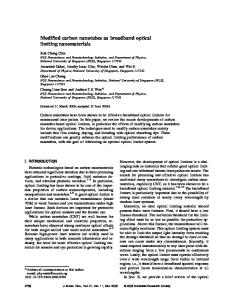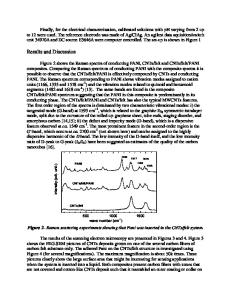Carbon Nanotubes as Optical Materials
- PDF / 836,606 Bytes
- 6 Pages / 612 x 792 pts (letter) Page_size
- 37 Downloads / 344 Views
1015-BB07-05
Carbon Nanotubes as Optical Materials Shaoxin Lu, Ning Shao, Ye Liu, and Balaji Panchapakesan University of Delaware, Newark, DE, 19716 ABSTRACT This paper discusses some of the highly interesting effects that occur when photons interact with carbon nanotubes. From position dependent photoconductivity of nanotube thin films to photon induced elastic actuation of carbon nanotubes is presented. A new field of micro-opto-mechanical systems (MOMS) is envisioned through the miniaturization of nanotube actuators using MEMS and CMOS processes. Number of remotely controlled MOMS devices including MOMS grippers, MOMS cantilevers and MOMS mirrors are presented. The performance of these devices rivals their MEMS electrostatic counterparts while consuming only fraction of energy and enabling remote controllability. Finally, the interaction of light with nanotubes for biomedical nanotechnology and photodynamic cancer therapy is presented. INTRODUCTION Single wall carbon nanotubes are known to be remarkable materials with high mechanical strength, unique electron transport properties, high thermal conductivity and biocompatibility. While there are plenty of reports on the mechanical, electronic, thermal and optical properties of single carbon nanotubes, the physical properties of ensembles of nanotubes and nanotube thin films is not well understood. Improved mastery of this field can reap great technological benefits and can create applications as diverse as microopto-mechanical systems to photodynamic cancer therapy. When photons interact with carbon nanotubes, it produces highly interesting effects such as bolometric photoconductivity [1], position dependent photoconductivity [2], photon induced elastic actuation of nanotube ensembles and thin films [3], thickness dependent transparency of nanotube thin films [4], light induced shape memory effects [5] and finally explosions of nanotube ensembles known as “Nanobombs” [6]. The ability to unlock these interesting effects can be useful for many practical applications. This paper presents some new insights into the interaction of photons with carbon nanotubes. Specifically, position dependent photoconductivity, pressure dependence of photoconductivity, orientation dependent photoelastic actuation of carbon nanotubes and microscopic explosions of nanotube ensembles also called “Nanobombs” is presented. EXPERIMENTAL DETAILS Single wall carbon nanotube thin films were first processed using vacuum filtration techniques [3]. For studying the photoconductivity of nanotube thin films, platinum electrodes were patterned onto glass slides of nanotube using photolithography, metal deposition and lift off. The nanotube thin films were directly placed on top of the electrodes. An additional electroplating was done to increase the contact area of the nanotube to metal. For studying photoconductivity 808 nm laser was collimated onto the samples. The light intensity was recorded using Newport 1815-C intensity meter. An Agilent 4156C semiconductor parameter analyzer was used for curr
Data Loading...











